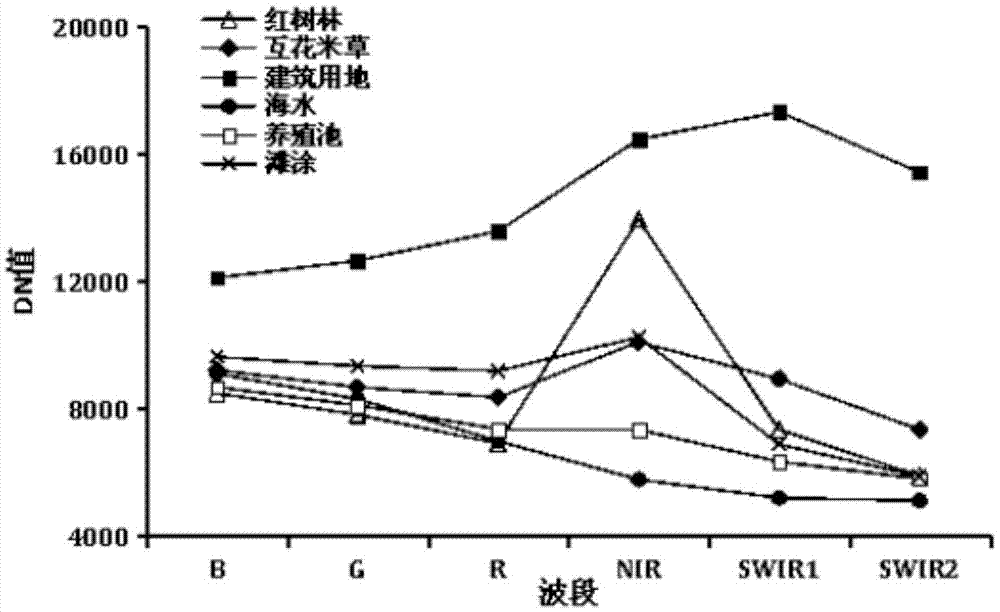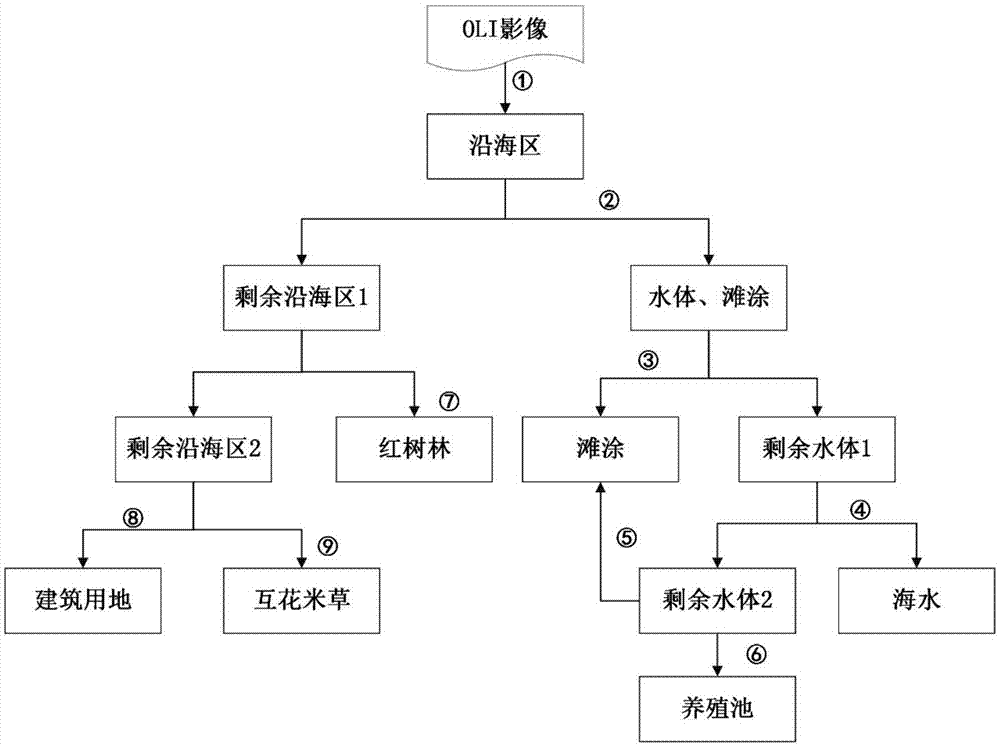Method of performing coastal wetland drawing for medium-resolution remote sensing image by utilizing object-oriented classification technology
A classification technology, object-oriented technology, applied in the field of coastal wetland mapping, which can solve the problems of enclave phenomenon and inability to accurately distinguish various wetland types.
- Summary
- Abstract
- Description
- Claims
- Application Information
AI Technical Summary
Problems solved by technology
Method used
Image
Examples
specific Embodiment approach 1
[0027] Specific Embodiment 1: A method of using object-oriented classification technology in this embodiment to carry out coastal wetland mapping on medium-resolution remote sensing images is implemented in the following steps:
[0028] Step 1: Download the Landsat8OLI image and the digital elevation model (DEM data), and perform preprocessing respectively, and predict the preprocessed Landsat8OLI image to determine the typical features of the coastal wetland;
[0029] Among them, the Landsat8OLI image preprocessing includes orthorectification and geometric fine correction; DEM preprocessing includes projection transformation to make the DEM consistent with the Landsat8OLI image coordinate system, and uses the Fill tool in ArcGIS to perform the processing of filling and cutting peaks.
[0030] Step 2: Carry out multi-scale segmentation on the Landsat8OLI image preprocessed in Step 1, merge adjacent pixels into objects according to the homogeneity standard, and obtain the image ...
specific Embodiment approach 2
[0038]Specific embodiment two: the difference between this embodiment and specific embodiment one is: in step four, it is determined that the characteristics that can be used to distinguish typical features of coastal wetlands are calculated based on eCognitionDeveloper8.64 software: according to the normalized difference vegetation index (NDVI), surface Humidity Index (LSWI), Soil Brightness Index (SBI), and Normalized Difference Water Index (NDWI) formulas, use the CreateArithmeticFeature tool in Objectfeatures to calculate the above arithmetic features of the object respectively; obtain the hue (Hue) feature after band combination through HIS transformation; Use the preprocessed DEM in step 1 as the feature layer, and use the LayerValues tool to calculate the DEM features of the image object.
[0039] Other steps and parameters are the same as those in Embodiment 1.
specific Embodiment approach 3
[0040] Specific implementation mode three: the difference between this implementation mode and specific implementation modes one or two is that the step five is specifically:
[0041] (1) In the image object layer obtained in step 2, using the calculation result of step 4, the object whose DEM is less than or equal to 10 and whose NDWI is between -0.08 and 0.32 is the area where the coastal wetland is located, named "coastal area";
[0042] (2) In the coastal area, the objects satisfying Hue (R='NIR', G='SWIR1', B='SWIR2') characteristics between 0.7 and 1 and NDVI less than 0.15 are water bodies and tidal flats, which do not meet The object of the condition is named "Remaining Coastal Zone 1";
[0043] (3) Among the water bodies and tidal flats, the objects satisfying that the LSWI is between 0.12 and 0.31 and the NDVI is greater than 0 are tidal flats, and the objects that do not meet the conditions are named "remaining water body 1";
[0044] (4) In the remaining water bod...
PUM
 Login to View More
Login to View More Abstract
Description
Claims
Application Information
 Login to View More
Login to View More - R&D
- Intellectual Property
- Life Sciences
- Materials
- Tech Scout
- Unparalleled Data Quality
- Higher Quality Content
- 60% Fewer Hallucinations
Browse by: Latest US Patents, China's latest patents, Technical Efficacy Thesaurus, Application Domain, Technology Topic, Popular Technical Reports.
© 2025 PatSnap. All rights reserved.Legal|Privacy policy|Modern Slavery Act Transparency Statement|Sitemap|About US| Contact US: help@patsnap.com



